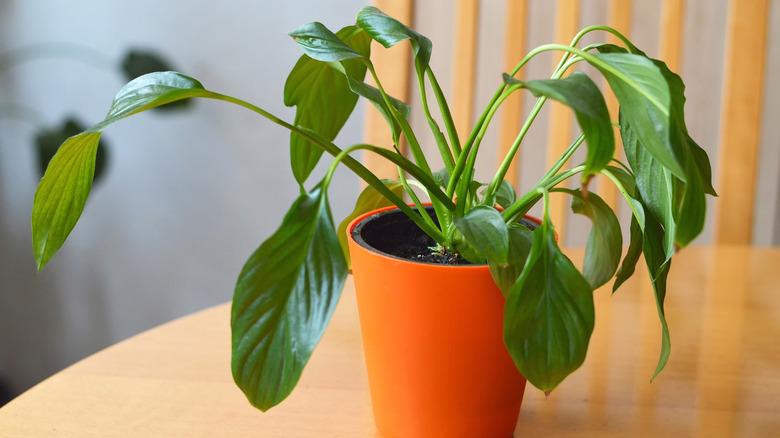The Big Mistake That's Making Your Peace Lily's Leaves Curl And Shrink
We may receive a commission on purchases made from links.
The peace lily (Spathiphyllum) is one of the most popular houseplants, and for good reason. This tropical plant produces glossy, pointed oval foliage and elegant, white flowers. There are many varieties of peace lily plants that are great for growing indoors, offering many choices to complement your interior space or design style. However, there is one big mistake that can lead to its leaves curling and shrinking: not giving your plant enough moisture, which is essential for its survival.
A peace lily's leaves curl as a response to water loss. Water inside each plant cell creates a pressure called turgor, which pushes against the cell's walls and helps provides the structural support a plant needs to remain upright and healthy. When water levels drop, this pressure decreases, causing a cell to lose its strength and develop leaf curling. Several factors can cause a peace lily to lack essential moisture, including not watering it enough, too much direct sunlight, or not enough humidity. Monitoring and correcting these conditions are essential to maintaining your plant's health. There are plenty of hacks to help your peace lilies flourish as an indoor houseplant. But if you don't first attend to your plant's curling leaves, it will soon wilt, collapse, and die.
How to water a peace lily
For a healthy amount of moisture, water your peace lily whenever the soil feels dry to the touch. You can use your finger as a gauge — stick it into the dirt up to the first joint, and if it feels dry, it's time to give it water. Add room temperature water, such as from a watering can, until you see the water begin to flow out of the pot's drainage holes. But don't allow the plant to sit directly in the drained water because it can promote root rot. Be sure to carefully monitor the condition of your plant's soil — overwatering your plant can be also dangerous — so allow the soil to dry out a bit between watering sessions.
Placing a pebble tray under the plant can help offer the humidity your peace lily craves. A humidifier, like a Pure Enrichment ultrasonic humidifier, can also provide essential humidity. A peace plant fares best in indirect light — harsh sunlight can scorch its leaves — so make sure the light is filtered, such as through the leaves of a tree outside the window or sheer curtains. A peace lily's leaves can also curl when it's getting too much heat, so don't place it directly in front of a heating vent; the warm air can dry it out.
It can take several weeks for your peace lily to fully recover once its leave have begun to curl. However, if you pair these peace lily care tactics with simple tips for keeping your houseplants healthy in any condition, you'll create an environment where it will thrive, astounding you with its vibrant leaves and beautiful blooms and adding serenity to your space.

